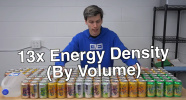djd09
Elite Member
- Joined
- May 20, 2009
- Professional Status
- Licensed Appraiser
- State
- Ohio
Unreliable. First, it works half the day on average over a year and is low input mornings and afternoons. Second, it can only work at night with storage. Next, these farms are huge and to do as much as half the energy we will need, will necessarily cover hundreds of square miles. So, where will they be built? Certainly not in the cities that consume the electricity. Nor will they cover government lands, mountains, oil fields, mines, subdivisions, so where? Where else? Millions upon millions of acres of farm and ranch land, the very breadbasket of the nation. So, I guess we won't starve in the dark at least, just starve. Fourth. By covering acres upon acres, we reduce the ability of vegetation to generate oxygen and consume CO2. So, we actually would create more CO2 with solar panels than we would as open spaces. Storage would consume all the resources 10x over what we need today.the dominant global energy source by 2050

Unreliable. First, it works half the day on average over a year and is low input mornings and afternoons. Second, it can only work at night with storage. Next, these farms are huge and to do as much as half the energy we will need, will necessarily cover hundreds of square miles. So, where will they be built? Certainly not in the cities that consume the electricity. Nor will they cover government lands, mountains, oil fields, mines, subdivisions, so where? Where else? Millions upon millions of acres of farm and ranch land, the very breadbasket of the nation. So, I guess we won't starve in the dark at least, just starve. Fourth. By covering acres upon acres, we reduce the ability of vegetation to generate oxygen and consume CO2. So, we actually would create more CO2 with solar panels than we would as open spaces. Storage would consume all the resources 10x over what we need today.
View attachment 101372
Energy density - Watch this video. When you see the requirement of
I take it you've not spent much time in the SW... Earthquakes are not uncommon. Tornados hit the front range often. And the desert is often quite fragile environmentally. Huge hail storms occur occasionally some with hail so large it killed antelope. Yes, it generates more energy but also loses a lot of that energy just transporting to the places where it can be used. And that brings up the issue of more and more power lines which necessarily will cross cropland, homes, ranches, and present environmental issues all their own. And again, this involves millions of acres whether a wind farm or a solar farm. Natural gas OTOH can build smaller, more cost effective power plants close to the places that need the power, but the reality is the only true low-carbon footprint is going to be nuclear power.What would be the issue in sticking giant farms in the south western desert? Nothing but heat and no real damaging storms
 PS - I've been in 4 such haboobs, 2 in the OK panhandle and 2 in western Colorado.
PS - I've been in 4 such haboobs, 2 in the OK panhandle and 2 in western Colorado.Heat. Solar panels are tested for peak efficiency at 77 deg F (25 deg C) operating temperature. That is not ambient temperature because they also generate their own heat. For every degree above 25 C they lose 0.5% in efficiencyWhat would be the issue in sticking giant farms in the south western desert?
